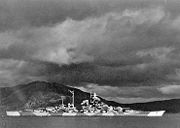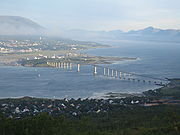
Operation Obviate
Encyclopedia


RAF Bomber Command
RAF Bomber Command controlled the RAF's bomber forces from 1936 to 1968. During World War II the command destroyed a significant proportion of Nazi Germany's industries and many German cities, and in the 1960s stood at the peak of its postwar military power with the V bombers and a supplemental...
attack on the German battleship Tirpitz
German battleship Tirpitz
Tirpitz was the second of two s built for the German Kriegsmarine during World War II. Named after Grand Admiral Alfred von Tirpitz, the architect of the Imperial Navy, the ship was laid down at the Kriegsmarinewerft in Wilhelmshaven in November 1936 and launched two and a half years later in April...
at Tromsø
Tromsø
Tromsø is a city and municipality in Troms county, Norway. The administrative centre of the municipality is the city of Tromsø.Tromsø city is the ninth largest urban area in Norway by population, and the seventh largest city in Norway by population...
on 29 October 1944. The attack was foiled by cloud covering the ship at the last minute, and the bombs that were dropped caused only minor damage. The Tirpitz would finally be sunk in Operation Catechism
Operation Catechism
Operation Catechism was the last of nine attempts to sink or sabotage the Kriegsmarine battleship Tirpitz during World War II. On November 12, 1944, the RAF Bomber Command dispatched 30 Avro Lancaster heavy bombers from No. 9 Squadron RAF and No. 617 Squadron RAF Operation Catechism was the last of...
two weeks later.
Background
The Tirpitz was a Bismarck class battleshipBismarck class battleship
The Bismarck class was a pair of battleships built by the German Kriegsmarine shortly before the outbreak of World War II. The ships were the largest warships built by the German Navy and the heaviest capital ships ever completed in Europe...
of 42,900 tons, armed with eight 38 cm (15 inch) guns. She was designed to attack merchant shipping in the Atlantic, but the loss of the Bismarck
German battleship Bismarck
Bismarck was the first of two s built for the German Kriegsmarine during World War II. Named after Chancellor Otto von Bismarck, the primary force behind the German unification in 1871, the ship was laid down at the Blohm & Voss shipyard in Hamburg in July 1936 and launched nearly three years later...
and other commerce raiders led to instructions that she should be used for limited sorties only. In early 1942, the Tirpitz was sent to northern Norway
Norway
Norway , officially the Kingdom of Norway, is a Nordic unitary constitutional monarchy whose territory comprises the western portion of the Scandinavian Peninsula, Jan Mayen, and the Arctic archipelago of Svalbard and Bouvet Island. Norway has a total area of and a population of about 4.9 million...
, where she would remain for most of World War II
World War II
World War II, or the Second World War , was a global conflict lasting from 1939 to 1945, involving most of the world's nations—including all of the great powers—eventually forming two opposing military alliances: the Allies and the Axis...
. She acted mainly as a fleet in being
Fleet in being
In naval warfare, a fleet in being is a naval force that extends a controlling influence without ever leaving port. Were the fleet to leave port and face the enemy, it might lose in battle and no longer influence the enemy's actions, but while it remains safely in port the enemy is forced to...
, threatening the Arctic convoys and tying up three British battleships that were needed elsewhere.
The Tirpitz had been damaged in Kåfjord
Kåfjord, Alta
Kåfjord is a fjord in northern Norway, an arm of the Altafjord, in the county of Finnmark, and a village located on the fjord. The village is in the municipality of Alta, 18 km west of the town of Alta on the European route E6....
by a raid (Operation Paravane
Operation Paravane
Operation Paravane was the attack carried out by RAF Bomber Command on September 15, 1944 against the German battleship Tirpitz at harbour in the far north of Norway. The Tirpitz was a major threat to the convoys supplying the Soviet Union. Flying via a Soviet airfield, two squadrons attacked...
) on 15 September 1944 by No. 617 Squadron
No. 617 Squadron RAF
No. 617 Squadron is a Royal Air Force aircraft squadron based at RAF Lossiemouth in Scotland. It currently operates the Tornado GR4 in the ground attack and reconnaissance role...
and No. 9 Squadron RAF from a base in Russia. The Germans decided that the ship could not be repaired and towed her 200 miles south, for use as a static battery in the defence of Tromsø against an expected Allied invasion. The British were unaware of the damage and so continued plans to sink the Tirpitz. However the move to Tromsø had brought her within range of aircraft flying from British airfields such as RAF Lossiemouth
RAF Lossiemouth
RAF Lossiemouth is a Royal Air Force station to the west of the town of Lossiemouth in Moray, Scotland. It is one of the RAF's biggest bases and is currently Britain's main base for Tornado GR4s. From 2013 the Northern QRA force of Typhoon F2 will relocate to Lossiemouth following the closure of...
.
Battleplans
When news came of the TirpitzRalph Cochrane
Air Chief Marshal Sir Ralph Alexander Cochrane, GBE, KCB, AFC, RAF was a British pilot and Royal Air Force officer, perhaps best known for his role in Operation Chastise, the famous "Dambusters" raid....
of No. 5 Group RAF
No. 5 Group RAF
No. 5 Group was a Royal Air Force bomber group of the Second World War, led during the latter part by AVM Sir Ralph Cochrane.-History:The Group was formed on 1 September 1937 with headquarters at RAF Mildenhall....
made plans for an attack using Tallboy bomb
Tallboy bomb
The Tallboy or Bomb, Medium Capacity, 12,000 lb, was an earthquake bomb developed by the British aeronautical engineer Barnes Wallis and deployed by the RAF in 1944...
s dropped from high altitude to penetrate the battleship's armour. However Tromsø was at the limits of the range of an Avro Lancaster
Avro Lancaster
The Avro Lancaster is a British four-engined Second World War heavy bomber made initially by Avro for the Royal Air Force . It first saw active service in 1942, and together with the Handley Page Halifax it was one of the main heavy bombers of the RAF, the RCAF, and squadrons from other...
bomber carrying a Tallboy. The planes needed an extra 300 gallons of fuel, but the Tallboy prevented the use of extra fuel tanks in the bomb bays. Cochrane's engineering staff officer, Wing Commander Brown, came up with the idea of using long, thin tanks from the Wellington
Vickers Wellington
The Vickers Wellington was a British twin-engine, long range medium bomber designed in the mid-1930s at Brooklands in Weybridge, Surrey, by Vickers-Armstrongs' Chief Designer, R. K. Pierson. It was widely used as a night bomber in the early years of the Second World War, before being displaced as a...
inside the fuselage of the Lancasters. This gave them a fuel capacity of 2,406 gallons, just enough for the 2,250 mile trip, but it left the aircraft 2 tons overweight, even after the mid-upper turret and some of the armour was removed. So "Willie" Tait
James Brian Tait
Group Captain James Brian Tait DSO and three bars, DFC and bar was an officer in the Royal Air Force during and after World War II. He conducted 101 bombing missions during the war, including those which finally sank the German battleship Tirpitz in 1944...
requisitioned more powerful Merlin 24 engines
Rolls-Royce Merlin
The Rolls-Royce Merlin is a British liquid-cooled, V-12, piston aero engine, of 27-litre capacity. Rolls-Royce Limited designed and built the engine which was initially known as the PV-12: the PV-12 became known as the Merlin following the company convention of naming its piston aero engines after...
from other Lancasters in 5 Group, and had them fitted into the aircraft of 617 and 9 Squadrons, which had specially modified bomb bays to carry the Tallboy. Then they had to wait for a break in the weather. Since the aircraft were required to be on standby for emergency tasks in France, they were only sent up to Lossiemouth from their bases in Lincolnshire
RAF Woodhall Spa
-History:Constructed on farmland 1 km south of Woodhall Spa, the station opened in February 1942 as a satellite station to RAF Coningsby. In August 1943 it became No 54 Base Substation. After victory in Europe the airfield was used as an assembly and kitting out point for Tiger Force...
when the weather looked like clearing.
The Tirpitz was moored south of the island of Håkøya, across the Sandnessundet from the main island of Tromsøya
Tromsøya
Tromsøya is a small island in the strait between the mainland and Kvaløya island in Tromsø municipality, Troms county, Norway. It contains the city centre and several residential areas of the city of Tromsø and has given the city its name. The island's area is roughly and has a population of...
. It was protected by two anti-aircraft ships and land-based flak batteries, but the smoke screen system was not yet operational.
Operation
On 28 October, 37 Lancasters - 18 from No 617 Suqadron, 18 from No 9, and a film unit aircraft from No 463 Squadron - flew north to Lossiemouth, and at 1am the following morning they set off at low level for Tromsø. They flew inland, to put the mountains between them and the Tromsø radar, but just as the ship came into view, the wind changed and banks of cloud started to come in from the sea. The cloud arrived at the Tirpitz 30 seconds before the Lancasters and they were forced to bomb "blind". 32 bombs were released, but no direct hits were scored. One near miss bent a propeller shaft.Carey lost one engine to flak on his first bomb run, and a second engine was hit as he turned for home. With only two engines running and several fuel tanks leaking, he was forced to head for the neutral territory of Sweden. He crash-landed safely in a bog near Porjus
Porjus
Porjus is a locality situated in Jokkmokk Municipality, Norrbotten County, Sweden with 317 inhabitants in 2005. Geographically it is situated by the shores of Lule River at 499 meter height....
and the crew were repatriated some weeks later.
Aftermath
The main effect of the raid was that the Germans moved 20-30 fighters to BardufossBardufoss Airport
Bardufoss Airport is situated at Bardufoss in the municipality of Målselv in Troms, North Norway. The airport is primarily military, but also serves a few civilian flights...
, 30 miles from Tromsø. This made further attacks on the Tirpitz much more dangerous, but she was finally sunk by the Lancasters in Operation Catechism
Operation Catechism
Operation Catechism was the last of nine attempts to sink or sabotage the Kriegsmarine battleship Tirpitz during World War II. On November 12, 1944, the RAF Bomber Command dispatched 30 Avro Lancaster heavy bombers from No. 9 Squadron RAF and No. 617 Squadron RAF Operation Catechism was the last of...
on 12 November 1944.

